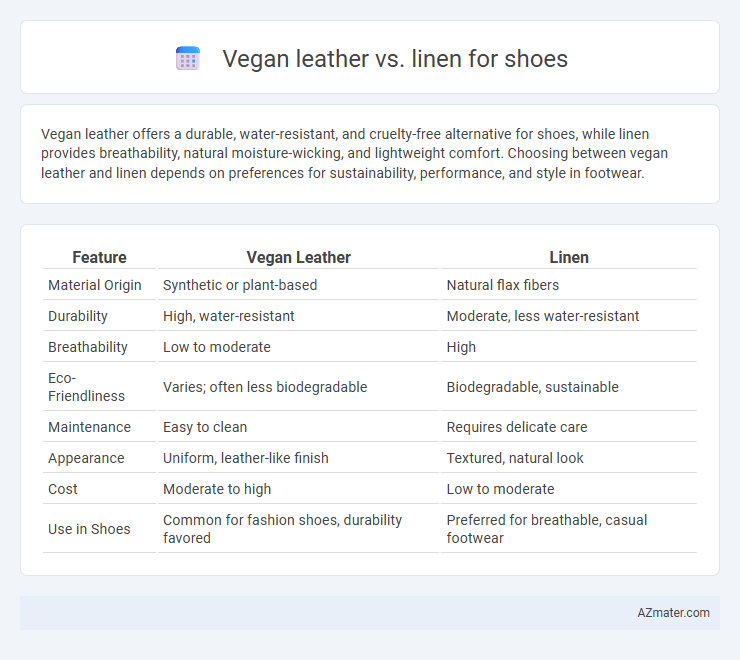Vegan leather offers a durable, water-resistant, and cruelty-free alternative for shoes, while linen provides breathability, natural moisture-wicking, and lightweight comfort. Choosing between vegan leather and linen depends on preferences for sustainability, performance, and style in footwear.
Table of Comparison
| Feature | Vegan Leather | Linen |
|---|---|---|
| Material Origin | Synthetic or plant-based | Natural flax fibers |
| Durability | High, water-resistant | Moderate, less water-resistant |
| Breathability | Low to moderate | High |
| Eco-Friendliness | Varies; often less biodegradable | Biodegradable, sustainable |
| Maintenance | Easy to clean | Requires delicate care |
| Appearance | Uniform, leather-like finish | Textured, natural look |
| Cost | Moderate to high | Low to moderate |
| Use in Shoes | Common for fashion shoes, durability favored | Preferred for breathable, casual footwear |
Introduction: Vegan Leather and Linen in Footwear
Vegan leather and linen are increasingly popular materials in sustainable footwear, each offering unique benefits for shoe construction. Vegan leather provides a cruelty-free alternative with a smooth, durable finish that mimics traditional leather's appearance. Linen, derived from flax fibers, delivers breathability, lightweight comfort, and eco-friendly properties ideal for casual and warm-weather shoes.
Material Origins: How Vegan Leather and Linen Are Made
Vegan leather is crafted from synthetic materials such as polyurethane or natural alternatives like cork and pineapple leaves, designed to mimic traditional animal leather's texture and durability without animal exploitation. Linen is made from flax plant fibers, which undergo processes like retting, scutching, and weaving to produce a strong, breathable fabric prized for its natural origin and sustainability. Both materials offer environmentally conscious options, with vegan leather emphasizing animal-free production and linen highlighting renewable plant-based sourcing.
Sustainability Comparison: Vegan Leather vs Linen
Vegan leather offers a cruelty-free alternative to traditional leather but often involves synthetic materials like polyurethane, which can have a higher environmental footprint due to plastic production and limited biodegradability. Linen, derived from flax plants, is a renewable resource that requires less water and fewer pesticides, making it a more sustainable choice with natural biodegradability and lower carbon emissions. Choosing linen over vegan leather for shoes supports eco-friendly manufacturing and reduces long-term environmental impact.
Durability and Longevity in Shoes
Vegan leather offers moderate durability and resistance to water and stains but tends to degrade faster under constant flexing and heat exposure, impacting the shoe's longevity. Linen, made from natural fibers, provides breathability and comfort but has lower resistance to abrasion and moisture, causing faster wear in high-stress shoe areas. For long-lasting footwear, combining vegan leather's weather resistance with linen's flexibility or opting for engineered blends enhances both durability and lifespan.
Comfort and Breathability Factors
Vegan leather, typically made from polyurethane or plant-based materials, offers moderate breathability but can trap heat and moisture, potentially reducing comfort during extended wear. Linen, a natural fiber derived from flax plants, provides superior breathability and moisture-wicking properties, enhancing overall foot comfort by allowing air circulation and reducing sweat buildup. For shoe applications prioritizing comfort and breathability, linen materials outperform most vegan leather alternatives due to their natural ventilation and temperature regulation capabilities.
Aesthetic Versatility and Style Options
Vegan leather offers a sleek, polished appearance with a wide range of colors and finishes, making it ideal for modern, sophisticated shoe designs. Linen provides a natural, breathable texture that enhances casual and eco-friendly styles, lending a rustic yet chic aesthetic. Both materials deliver distinct style options, with vegan leather excelling in versatility for formal looks and linen favoring relaxed, artisanal footwear.
Water Resistance and Weather Suitability
Vegan leather, typically made from polyurethane or plant-based materials, offers superior water resistance compared to linen, making it more suitable for wet or rainy conditions. Linen, a natural fiber, is breathable and lightweight but tends to absorb moisture quickly, reducing its durability in damp weather. For shoes intended for variable weather, vegan leather ensures better protection and longevity by repelling water and withstanding exposure to different environmental elements.
Maintenance and Cleaning Requirements
Vegan leather shoes typically require regular cleaning with a damp cloth and mild soap to maintain their appearance and prevent cracking, while avoiding harsh chemicals that can damage the synthetic material. Linen shoes demand gentle washing, preferably spot cleaning or hand washing, as machine laundering can weaken the fibers and cause shrinkage or distortion. Both materials benefit from air drying away from direct heat to preserve integrity and prolong shoe lifespan.
Cost Analysis: Vegan Leather vs Linen Shoes
Vegan leather shoes typically cost more than linen shoes due to synthetic material production and processing expenses, ranging from $50 to $150 for mid-tier brands, while linen shoes often fall between $30 and $80. Linen shoes offer cost-effective benefits with their natural fibers and simpler manufacturing methods but may require more frequent replacement due to durability concerns compared to vegan leather. Consumers seeking affordable, sustainable footwear frequently prefer linen for budget-friendly options, whereas vegan leather appeals to those emphasizing animal-free materials despite higher prices.
Consumer Preferences and Market Trends
Consumer preferences for vegan leather shoes are driven by increasing demand for sustainable and cruelty-free materials, with younger demographics showing strong support for ethical fashion choices. Linen shoes appeal to environmentally conscious buyers valuing breathability, natural fibers, and lightweight comfort, often favored in warmer climates and casual wear. Market trends indicate a growing shift toward innovative plant-based vegan leathers and eco-friendly textile blends that balance durability with environmental impact to meet diverse consumer needs.

Infographic: Vegan leather vs Linen for Shoe
 azmater.com
azmater.com